#studykorean
3 달 동안 열심히 공부한 후에, 어제 제 TEFL 과정을 마쳤어요 ~! 많은 것을 읽어야했지만 어렵지 않았어요. 그냥 단조로웠고 조금 지루했어요. 흥미로운 것은 배우지 않았고 단지 아이들을 가르치고 수업 계획을 쓰는 경험이었어요. 또한 저는 이민자 가정에서 왔어요. 그래서 어려운 영어 개념을 설명하는 것은 부모님을 위해 항상 해왔 던 일이에요. 어쨌든 저는 이제 한국에서 교육 일자리 신청을 할 수 있어요!
After diligently studying for 3 months, I completed my TEFL course yesterday. It was just tedious and a little boring. I didn’t learn anything particularly interesting. Because I have experience teaching children and making lesson plans. Also, I come from a family of immigrants, so explaining difficult concepts of English is something I’ve always done for my parents. Anyway, now I can start applying for teaching jobs in Korea!
A lot of people liked PART TWO a lot! Thank you for all your kind comments and praise! PART THREE will cover the skin and necessary vocabulary underneath. Enjoy <3

*picture is of a chest (half skeleton, half muscle) and a skull (necessary vocabulary is highlighted)
- 뼈대 - skeleton
- skeleton can also be translated as: 해골 and 골격
- major differences between 뼈대, 해골, and 골격: 뼈대 and 해골 are the most similar. Sometimes 해골 can refer to only the skull (see skull for a better understanding) - both of these refer to dead skeletons. However, 해골 comes from 한자 ‘骸骨’. The word 골격 also comes from 한자 meaning 骨格 (frame, figure) or 骨骼 (skeleton).
- 근육 - muscle
- 뼈 - bone
- 인대 - ligament
- 살 - flesh (not skin, but the ‘meaty-like’ part; almost like fat)
- 관절 - joint
- 두개골 / 해골 - skull
- major difference between 두개골 and 해골: both come from 한자 ( 두개골 = 頭蓋骨 // 해골 = 骸骨), however, 해골 (according to a Korean native speaker), refers to the picture of a skull. Whereas 두개골 refers to the actual, physical skull.
- 광대뼈 - cheekbone
- 아래턱뼈 - mandible (jaw)
- 코뼈 - nasal bone
Example Sentences:
- 다행히뼈에는 이상이 없나요 - Fortunately, there is nothing wrong with the bone(theboneis alright/not broken).
- 우리 오빠는 축구를 하다 인대가 늘어났어요 - My brother pulled a ligamentwhile playing soccer.

*picture is of an eye and a pair of lips with blemishes (necessary vocabulary is highlighted)
- 피부 - skin
- 여드름 - pimple / zit
- 기미 / 주근깨 - freckles
- major difference between 기미 and 주근깨: 기미 refers to spots you get from the sun (not usually pleasant) while 주근깨 translated to actual freckles
- 다래끼 - sty
- 수염 - facial hair (this can be a mustache or beard)
- 애교 살 - the fatty pocket under the eyes
- 다크서클 - dark circles
- 점 - mole, spot
- 흉터 / 흠 - a scar, blemish
- major difference between 흉터 and 흠: 흉터 refers to an actual scar made a long time ago whereas 흠 considers all types of blemishes or flaws on the skin
- not to be confused with 상처 (injury/wound that JUST happened) and 멍자국 (bruise)
- 입슬허피스 / 입슬의 발진 - cold-sore
- difference: 입슬허피스 = lip herpes VS 입슬의 발진 = lip rash
Example Sentences:
- 여드름을 짜다가 세균에 감염될 수도 있어요 - If you pop your pimples, you might spread germs.
- 저는 작녀에 얼굴에 있는 점들을 뺐어요 - I had a few molesremoved.
Extra Vocab to Know:
- 주름(살) - wrinkles / crease
- 혹 - bump / lump
- 땀 - sweat
- 눈곱 - sleep (the goop in your eye when you wake up; eye boogies)
- 하품(하다) - sigh (to sigh)
- 방귀 - fart
- 트림(하다) - burp (to burp)
- 소름 - goosebumps / goose pimples
- 딸꾹질(하다) - hiccup (to hiccup)
I received an ask last night asking about the word for ‘throat’. You could use 목 to describe your throat but a more technical term would be 목구멍. However, this isn’t used as often. For example:
목이 아프다 - a sore throat
희주는 눈물에 목이 메였다 - tears clogged Hee-Ju’s throat
Hope that clears up some confusion!
Happy Learning :)
~ SK101
As promised, here’s PART TWO of the in depth body vocab!PART ONEcovered the face / head. Today we will look at the back, torso, and most internal organs. Enjoy <3
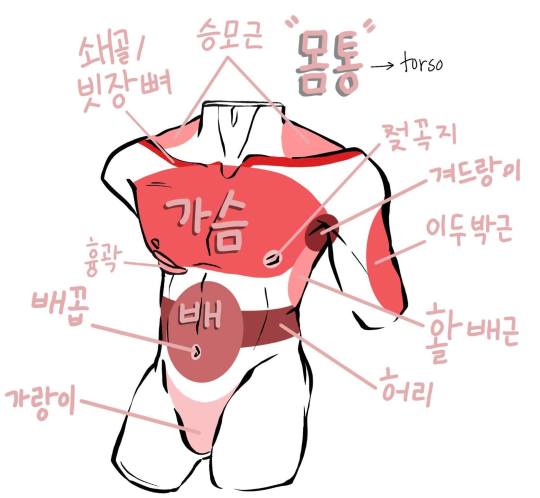
*picture is of a male presenting torso (necessary vocabulary is highlighted)
- 몸통 - torso
- 승모근 - traps
- 쇄골 / 빗장뼈 - collar bone
- major difference between 쇄골 and 빗장뼈: Both can translate to the scientific name ‘clavicle’. However, 쇄골 comes from 한자: ‘鎖骨’.
- 흉곽 - ribcage
- 가슴 - chest / breast
- 젖꼭지 - nipple
- 겨드랑이 - armpit
- 겨드랑이 털 - armpit hair
- 이드박근 - bicep
- 배 - belly, stomach (exterior)
- 배꼽 - bellybutton
- 활배근 - lats
- 허리 - waist
- 가랑이 - crotch
Example Sentences:
- 저는겨드랑이에서 땀이 괴도하게 났었어요 - I used to sweat a lot in my armpits
- 밥을 많이 먹어서 배가 너무 불러요 - My stomachis full because I ate too much

*blank back cut off at the legs and neck (necessary vocabulary is highlighted)
- 등 - back
- 목 - neck
- 어깨 - shoulder
- 팔 - arm
- 왼팔 - left arm
- 오른팔 - right arm
- 양팔 - both arms
- 삼두근 - triceps
- 팔꿈치 - elbow
- 척추 - spine
- not to be confused with 척수 which refers to the spinal cord
- 허리 - waist
- 옆구리 - side
- 허리께 - hip
- 엉덩이 - butt / buttocks
Example Sentences:
- 양팔을 위로 줄 뻗어 보세요 - Please stretch your armsout
- 하루 종일 앉아 있었더니엉덩이가 아파요 - My butthurts from sitting on it all day
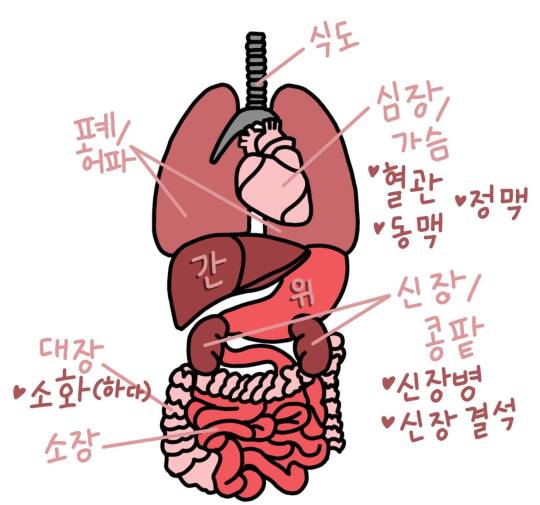
*picture of internal organs including the lungs, heart, liver, stomach, kidneys, and intestines (necessary vocabulary is highlighted)
- 장기 - organ
- 식도 - esophagus (’gullet’ in reference to animals)
- 폐 / 허파 - lung
- major difference between 폐 and 허파: 폐 is used in more medical contexts over 허파
- 심장 / 가슴 - heart
- major difference between 심장 and 가슴: 심장 refers to the literal pumping organ whereas 가슴 is the general area of the chest but can be used as an emotional heart (as opposed to 마음, which is the feeling in your heart)
- 혈관 - blood vessel
- 정맥 - vein
- 동맥 - artery
- 간 - liver
- 위 - stomach (internal)
- 신장 / 콩팥 - kidney
- major difference between 신장 and 콩팥: 신장 comes from 한자: ‘腎臟’, where 콩팥 is the native Korean version.
- 신장병 - kidney disease
- 신장 결석 - kidney stone
- 장 - intestine
- 대장 - large intestine
- 소장 - small intestine
- 소화 (하다) - digestion (to digest)
- 혈액 / 피 - blood
- major difference between 혈액 and 피: 혈액 is the medical form!
Example Sentences:
- 저는 수년간 위에 문제가 있어 왔어요 - I’ve had issues with my stomach for years
- 어젯밤 먹은 게 고화가 잘 안 돼요 - I’m having trouble digesting what I ate last night
Extra Vocab to Know:
- 배설(하다) - excretion (to excrete)
- 대변 / 똥 - stool or poop
- major difference between 대변 and 똥: 대변 is more like feces whereas 똥 is much more casual in speech
- 소변 / 오줌 - urine or pee
- major difference between 소변 / 오줌: same as above, 소변 is more like urine where 오줌 is more casual
- both 소변 and 대변 come from 한자: 大便 (대변) and 小便 (소변)
- 싸다 - to poop/pee
- 누다 - to poop
- 음경 - penis
- 자궁 - womb
This is obviously for educational purposes, so I hope tumblr lets it stay up. But here’s PART TWO of the in depth body vocab!
Happy Learning :)
~ SK101

I will be honest with you, this is my account I’m running in instagram LOL
However, it’s still true that this is a good resource to train your hangeul reading skill, learn new Korean vocabularies and practice what you’ve learnt.
https://www.instagram.com/koreanwordchain/
:: Concept
Here, you can learn many words by playing a word chain game. On the first day of the month, I suggest a word and you suggest the next day’s word ‘that begins with the syllable that the previous word ended with’. Like this, we are going to play a month-long game together, studying Korean together!
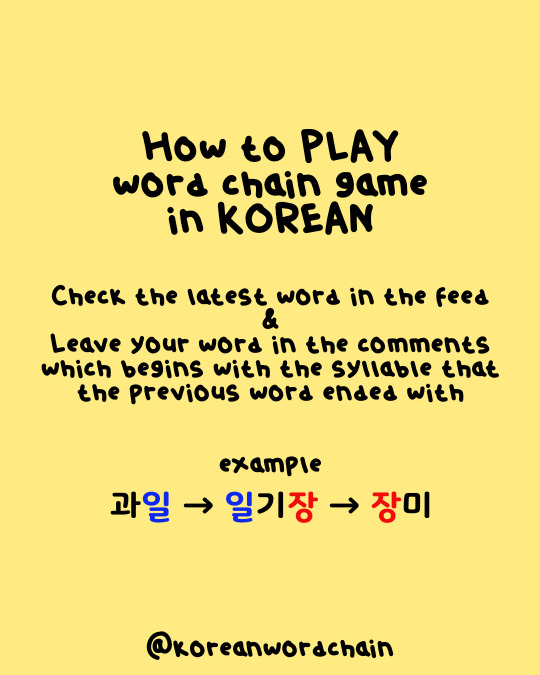
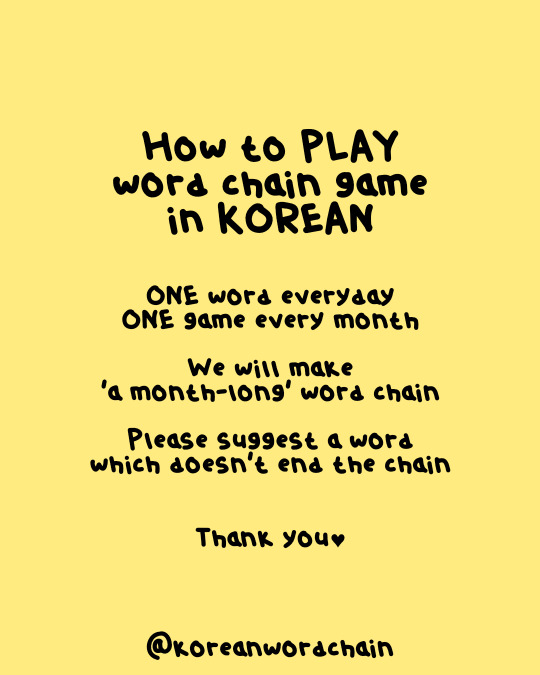
:: Benefits
1. Learn by playing
Just play a word chain game here and you’ll find yourself learning without any pressure about vocabularies! If you are fed up with boring vocab books, Korean Word Chain will be refreshing your mind and boost your study!
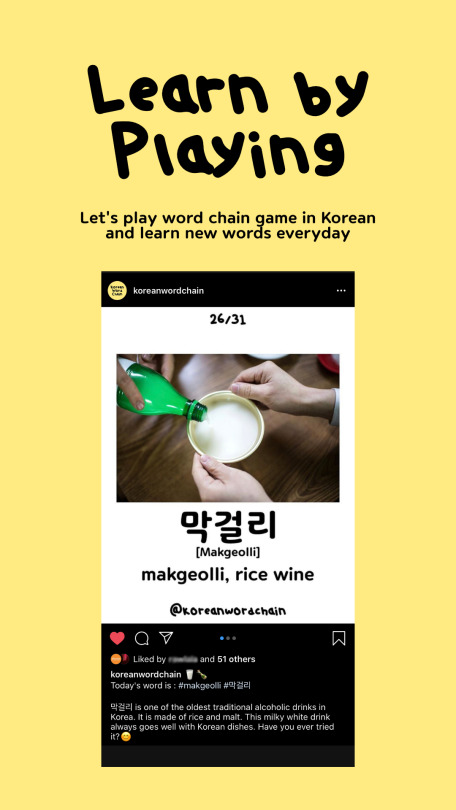
2. Actual practice
Once you’ve learned a word, it’s not yet finished until you actually use it in practice! You can use the words you studied by participating this game. To find the next word of the game, you will literally rummage your brain or you may can also find new words.
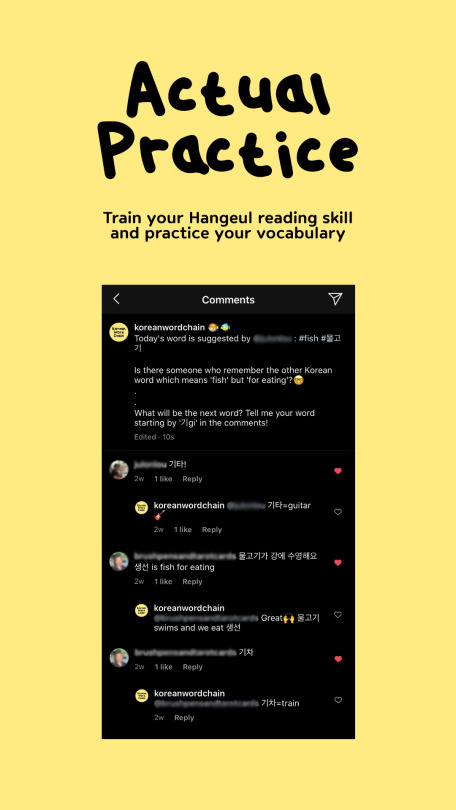
3. Flash Cards & Pronunciation
From day 1 to 30, you are going to play the word chain game. On the last day of the month, there will be two videos on my youtube channel. A vocabulary video and a flash card video with the pronunciation by professional voice actor(Her Voice is AMAZING, you must check it!).
:: Course
This FREE and FUN course of three steps will be repeated every month. You can learn, talk, interact, share a wealth of every information about Korean here.
From day 1 to 30, on instagram account @koreanwordchain, you are going to play the word chain game. During the game, I provide you the flash cards and quiz in my instagram story and highlight.
https://www.instagram.com/koreanwordchain/
On the last day of the month, you can go check my youtube channel @JIJEON Korean and have the flash cards video with NATIVE Korean pronunciation.
https://www.youtube.com/channel/UCev1GTOtHZuWcy9oWiqG1GA
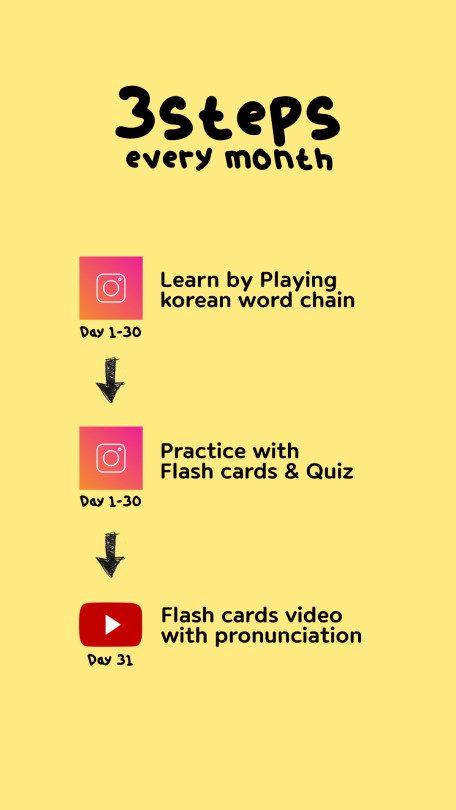
Though I didn’t post that often here in Tumblr but many of you, like almost 900 people, gave big love to this account(Still growing)! I’ve thought a lot about good Korean studying contents for you but I feel a lot of limit in this platform ;(
That is why I chose Instagram instead and here I came to invite you to my IG account @koreanwordchain.
https://www.instagram.com/koreanwordchain/
I provide not just a word but also many useful informations related to the topic word of the day. Please visit and support my account and let’s communicate more there! Thank you for reading this big promoting post and See you in IG!
안녕하세요. 주말 잘 보내 셨는지요?
Hola todos. Pasaron bien su fin de semana?
한국에서는 아파트 생활에 익숙하다 보니, 그런일이 많지 않았는데..
여기 미국에서는 집에서 무척이나 많은 곤충들과 같이 지내는것 같습니다 ^^
Viviendo en Corea donde se acostumbra a vivir en departamentos, no pasa muy seguido…
Pero aca en México es normal convivir con una gran variedad de insectos. ^^
특히, 개미는 엄청난 수의 무리를 동원하여…
음식 부스러기를 엄첨난 의지를 가지고 공략?? 하곤 하지요.. ㅎㅎ
항상 드는 생각이지만, 곤충들의 조직력은 상상을 초월 하는듯 합니다. !!
En especial las hormigas que movilizan un gran ejército…
Y atacan con gran intencidad los restos de comida… jaja
Siempre que veo pienso que los insectos estan a un nivel de organización no imaginado por nosotros.!!
오늘은 체계적인 조직 체계를 가지고 있는 곤충중 꿀벌 이야기를 같이 공유할까 합니다..
Hoy les platicaré de un insecto que tiene un sistema organizacional sistemático, La Abeja Mielera.
꿀벌은 조직의 절대적인 리더로 자리 잡고 있는 여왕벌을 중심으로 조직을 운영합니다…
Las abejas se organizan alrededor de una abeja reina como su líder absoluto de la organización.
1. 여왕벌, 일벌, 숫벌 등 잘 짜여져 있는 역할 분담 체계 및 유기적인 협업을 통해 조직을 효율적으로 운영 하지요..
2. 자율적으로 현장에서의 조직별 움직이고, 필요한 즉각적인 의사 결정 체계를 가지고 있습니다.
3. 그리고 리더인 여왕벌은 무리에 필요한 인력을 공급하고 , 무리의 번성을 책임지는 역할을 가지고 있지요.
1. La operación efectiva de la organización a través de un sistema de participación de roles bien organizado y la colaboración orgánica, la abeja reina, la abeja obrera y la abeja macho.
2. Con movimientos independizados por grupo tienen un sistema de toma de decisiones autónomo e inmediato, sobre el terreno.
3. Y la abeja reina, el líder, tiene el papel de suministrar la mano de obra necesaria para la colmena y para el florecimiento del panal.
우리 미주 모든 법인, 조직이
1. 보다 체계적인 조직 체계를 갖추고
2. 각 조직 마다 보다 자율적인 운영구조로 운영이 되어야 하며,
3. 각 리더는 이를 지원하고 최종의 성과를 책임지는 역할을 할때
En nuestra corporación, organización,
1. Tener una estructura organizacional más sistemática
2. Cada organización debe operar con una estructura operativa más autónoma,
3. Cada líder apoya esto y asume la responsabilidad del resultado final
우리가 꿈꾸는 멋진 조직이 되지 않을까 합니다 !!!
Lograremos asi la organizacion soñada por todos!!!
이를 위해 리더는 리더대로, 구성원은 구성원대로 노력해야 하는 일들이 있겠지요..
하루 하루의 시간이 더욱 탄탄한 조직을 만들어 가고 있음을 느끼면서 앞으로 전진 했으면 합니다 !!
Para hacer esto, hay cosas que el líder debería hacer como líder y los miembros como miembros.
Quisiera poder seguir en mi caminio sabiendo que estamos formando una organizacion mas resistente día a día.
좋은 한주 보내세요 ..^^
Que tengan un buen día .. ^^

